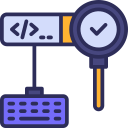Leveraging Coding Techniques for Efficient Audits
Harnessing coding techniques in the realm of auditing represents a transformative leap forward in efficiency, accuracy, and overall impact. Auditors, previously confined to manual data analysis and traditional tools, can now apply programming methods to expedite key processes, uncover more nuanced insights, and minimize errors. This web page explores the strategic application of coding within audits, highlighting how automation and customization can redefine audit workflows, enhance data integrity, and empower audit professionals to deliver more value to their organizations.

Streamlining Audit Processes Through Automation
Coding enables audits to move beyond manual data collection by interfacing directly with data systems. Automated scripts can fetch data from multiple sources—such as databases, ERP systems, or cloud applications—in real time, ensuring the latest information is always available for analysis. This reduces Lag Time, streamlines initial audit preparations, and allows for more frequent or continuous auditing. Importantly, automated collection minimizes the risk of data entry errors, standardizes data formats from heterogeneous environments, and ensures a repeatable process that is easily auditable itself.
Custom Analytics for Risk Assessment
With coding, auditors are equipped to create tailored analytical models that address the specific risk profile of each audited business process. These models can incorporate a wide range of variables and historical data to evaluate risk more accurately than one-size-fits-all templates. Programming techniques enable dynamic adjustment to changing business conditions or regulations, ensuring that risk assessments remain current and relevant. This personalized analytic approach leads to more targeted audit procedures, more effective resource allocation, and stronger overall risk management.
Outlier and Anomaly Detection
Programming empowers auditors to efficiently scan entire datasets for anomalies that might indicate fraud, error, or breakdowns in control. Sophisticated algorithms—such as clustering, regression testing, or even machine learning classifiers—can be deployed to flag unusual transactions or patterns deserving of closer scrutiny. Coding facilitates rapid iteration, making it easy to refine these detection techniques as new threats or types of noncompliance emerge. By identifying anomalies early, auditors can prevent small issues from becoming bigger problems and deliver greater assurance to stakeholders.
Integrating Predictive Analytics
Utilizing coding, auditors can harness predictive analytics to forecast trends, resource needs, or emerging risks before they crystallize into significant issues. By modeling future scenarios based on historical and real-time data, audit teams can anticipate challenges and advise on proactive corrective action. Integration of predictive analytics into audits supports organizations in strategic planning, resilience, and compliance, moving the audit function from a solely retrospective review to a forward-looking advisor. This transformative capability sets modern audits apart and ensures they deliver actionable guidance in dynamic environments.

Improving Accuracy and Reducing Human Error
Manual intervention in audits introduces a host of potential errors, from data entry mistakes to oversight in computations and reporting. Coding enables the automation of audit tasks, thereby minimizing manual touchpoints and reducing the error rate significantly. Programs can be tested, validated, and reused to ensure each execution is as accurate as the last. As a result, auditors can confidently rely on their outputs, secure in the knowledge that manual inconsistencies are virtually eliminated, and focus their energy on more strategic audit tasks.

